#Create Anatomy Slides Presentation
Text
Anatomy Slides Template
Create Anatomy Slides Presentation, free Anatomy Slides Template, online Anatomy Slides Template
The Anatomy Slides Template is a meticulously designed PowerPoint presentation framework aimed at educators, students, and professionals in the field of medicine, biology, and related disciplines. This template offers a structured yet flexible approach to presenting the complex subject of human anatomy, making it accessible and engaging for audiences of all levels. It combines detailed visual aids with concise, informative text to facilitate a comprehensive understanding of the human body's structure and function.
Title Slide
Design: A compelling image of the human body or an anatomical illustration that sets the tone for the presentation.
Content: Presentation title, such as "Exploring Human Anatomy: An In-Depth Guide," along with the presenter's name and date.
Agenda
Design: Clean, organized layout with medical or anatomical icons for bullet points.
Content: Overview of the presentation sections, including Introduction to Human Anatomy, Skeletal System, Muscular System, Nervous System, Circulatory System, Respiratory System, Digestive System, and Conclusion.
Introduction to Human Anatomy
Design: A blend of historical anatomical illustrations and modern imaging, creating a bridge between tradition and current science.
Content: Definitions, the importance of anatomy in medicine, and an overview of anatomical terminology and human body planes.
Skeletal System
Design: High-resolution images and 3D models of the skeletal system, highlighting individual bones and their connections.
Content: Functions of the skeletal system, bone structure, major bones of the human body, and common pathologies.
Muscular System
Design: Detailed diagrams and animations showcasing major muscle groups and their mechanisms of action.
Content: Overview of muscle types, muscle anatomy, the role of muscles in movement and posture, and muscular health.
Nervous System
Design: Interactive slides featuring the central and peripheral nervous systems, using neural network animations to depict nerve signal transmission.
Content: Structure and function of the nervous system, including the brain, spinal cord, and nerves, along with information on neurological disorders.
Circulatory System
Design: Vivid illustrations and flowcharts describing the heart, blood vessels, and blood flow throughout the body.
Content: The heart's anatomy, the blood circulation process, and common cardiovascular diseases.
Respiratory System
Design: Schematic representations and real-life images to explain the respiratory process and lung function.
Content: Anatomy of the respiratory system, gas exchange mechanism, and respiratory health issues.
Digestive System
Design: Detailed charts and models tracing the path of food through the digestive tract, highlighting key organs.
Content: Digestive organ functions, the digestion process, and nutritional aspects of human anatomy.
Additional Sections
Depending on the audience and purpose, the template can include slides on the endocrine, urinary, reproductive, and integumentary systems, each with tailored designs and content.
Conclusion
Design: A powerful, human-centric image that encapsulates the marvel of human anatomy.
Content: Summary of key points, the interconnectivity of body systems, and the significance of anatomical knowledge in health and disease.
Design Elements
Color Scheme: A palette that balances clinical precision with approachability, using neutral backgrounds and color-coded systems for clarity.
Fonts: Professional, easy-to-read fonts that maintain readability over detailed or textured backgrounds.
Icons and Symbols: Medical and anatomical icons enhance understanding and visual appeal.
Transitions and Animations: Tastefully used to emphasize points without detracting from the educational content.

1 note
·
View note
Text
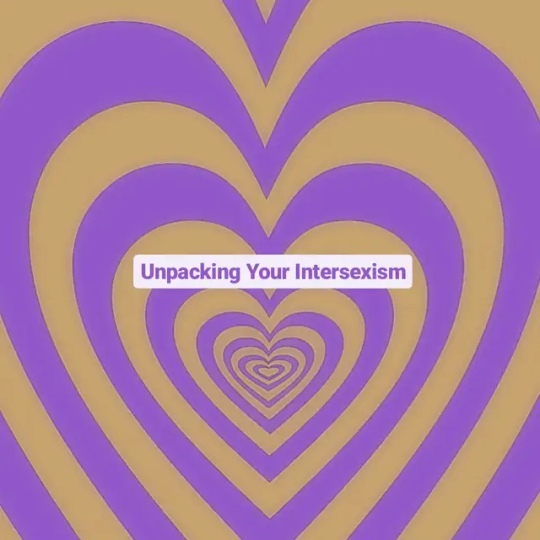

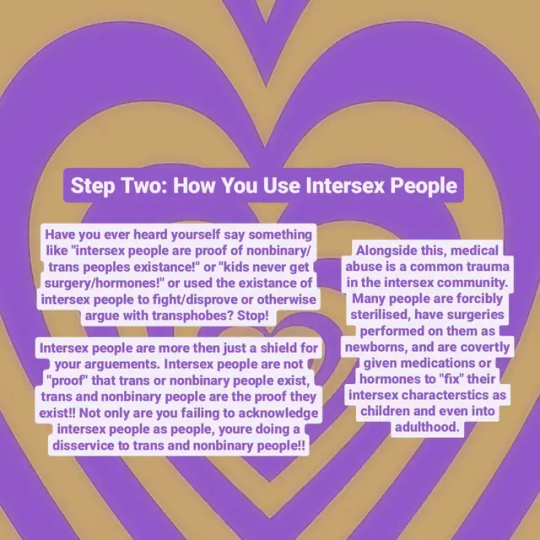
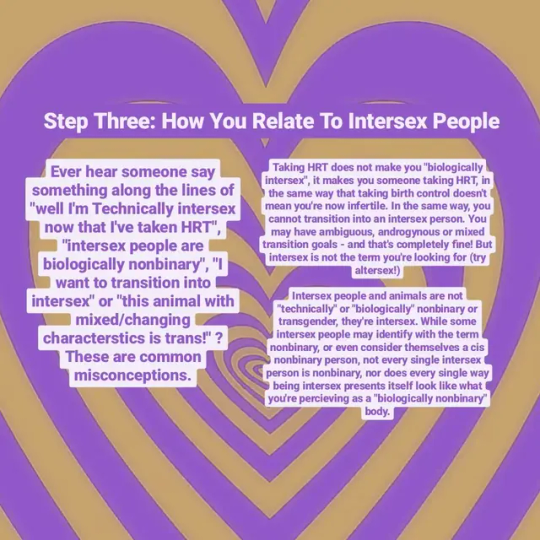

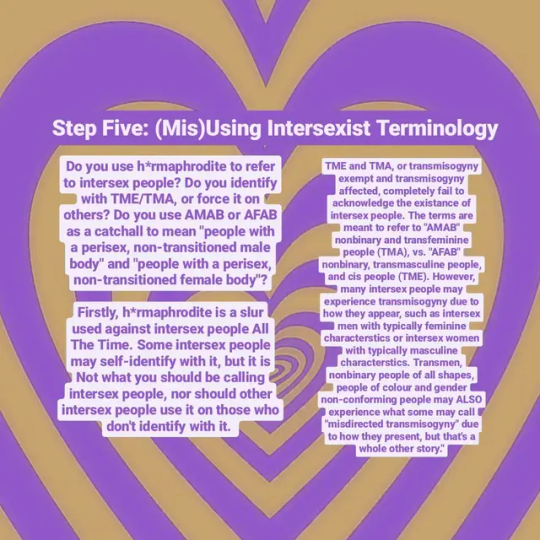
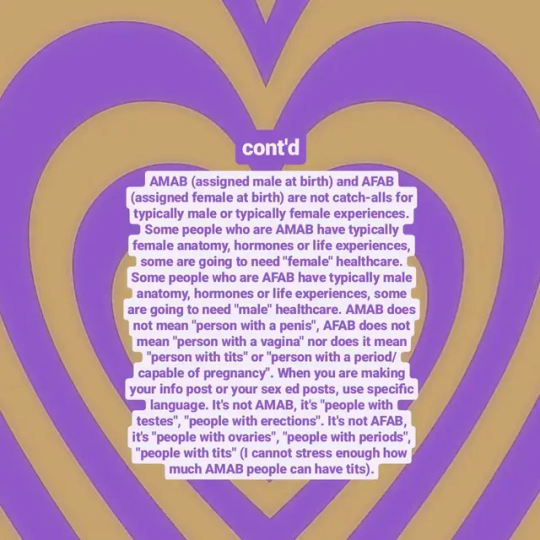
Decided to migrate my insta posts over to tumblr as well!! 🪻🌻 (I also have an intersex-focused discord server welcome to all - dm for link)
[ID:
Purple and yellow heart illusion background for all slides. Reads: Unpacking Your Intersexism
Step One: How You Imagine Intersex People
When you think of an intersex person, or an intersex body, what do you envision? Is it an assumption of their characteristics and anatomy? Does it group ALL intersex people into one tiny box?
Intersex people come in a variety of shapes, colours and genders. Some may look exactly like a woman or man, some may function one way but look the other, some are a mixed bowl. Stop creating a poster child for what an intersex person looks like!!
Step Two: How You Use Intersex People
Have you ever heard yourself say something like "intersex people are proof of nonbinary/trans peoples existance!" or "kids never get surgery/hormones!" or used the existance of intersex people to fight/disprove or otherwise argue with transphobes? Stop!
Intersex people are more then just a shield for your arguements. Intersex people are not "proof" that trans or nonbinary people exist, trans and nonbinary people are the proof they exist!! Not only are you failing to acknowledge intersex people as people, youre doing a disservice to trans and nonbinary people!!
Alongside this, medical abuse is a common trauma in the intersex community. Many people are forcibly sterilised, have surgeries performed on them as newborns, and are covertly given medications or hormones to "fix" their intersex characterstics as children and even into adulthood.
Step Three: How You Relate To Intersex People
Ever hear someone say something along the lines of "well I'm Technically intersex now that I've taken HRT", "intersex people are biologically nonbinary", "I want to transition into intersex" or "this animal with mixed/changing characterstics is trans!" ? These are common misconceptions.
Taking HRT does not make you "biologically intersex", it makes you someone taking HRT, in the same way that taking birth control doesn't mean you're now infertile. In the same way, you cannot transition into an intersex person. You may have ambiguous, androgynous or mixed transition goals - and that's completely fine! But intersex is not the term you're looking for (try altersex!)
Intersex people and animals are not "technically" or "biologically" nonbinary or transgender, they're intersex. While some intersex people may identify with the term nonbinary, or even consider themselves a cis nonbinary person, not every single intersex person is nonbinary, nor does every single way being intersex presents itself look like what you're percieving as a "biologically nonbinary" body.
Step Four: How You Treat Intersex People
Think to yourself - are you asking invasive questions (such as their variation or anatomy)? Are you including intersex people in your queer activism or art? Are you consuming intersexist media, or media that fetishises intersex bodies?
Intersex people NEVER owe you any information on their condition. You are not owed their anatomical features, their intersex variations, their hormone levels or their chromosomes. You should not be asking if they're infertile, whether they can have sex, or any other invasive question.
While not ALL intersex people identify with the queer community, many do. If you create queer art, merchandise or anything else created with queer symbols and flags - are you including intersex people? If not, why? Do you acknowledge how bills will affect intersex people, or do you call them collateral damage? Are you lifting up intersex voices, or pushing them out of queer spaces?
Step Five: (Mis)Using Intersexist Terminology
Do you use h*rmaphrodite to refer to intersex people? Do you identify with TME/TMA, or force it on others? Do you use AMAB or AFAB as a catchall to mean "people with a perisex, non-transitioned male body" and "people with a perisex, non-transitioned female body"?
Firstly, h*rmaphrodite is a slur used against intersex people All The Time. Some intersex people may self-identify with it, but it is Not what you should be calling intersex people, nor should other intersex people use it on those who don't identify with it.
TME and TMA, or transmisogyny exempt and transmisogyny affected, completely fail to acknowledge the existance of intersex people. The terms are meant to refer to "AMAB" nonbinary and transfeminine people (TMA), vs. "AFAB" nonbinary, transmasculine people, and cis people (TME). However, many intersex people may experience transmisogyny due to how they appear, such as intersex men with typically feminine characterstics or intersex women with typically masculine characterstics. Transmen, nonbinary people of all shapes, people of colour and gender non-conforming people may ALSO experience what some may call "misdirected transmisogyny" due to how they present, but that's a whole other story."
AMAB (assigned male at birth) and AFAB (assigned female at birth) are not catch-alls for typically male or typically female experiences. Some people who are AMAB have typically female anatomy, hormones or life experiences, some are going to need "female" healthcare. Some people who are AFAB have typically male anatomy, hormones or life experiences, some are going to need "male" healthcare. AMAB does not mean "person with a penis", AFAB does not mean "person with a vagina" nor does it mean "person with tits" or "person with a period/capable of pregnancy". When you are making your info post or your sex ed posts, use specific language. It's not AMAB, it's "people with testes", "people with erections". It's not AFAB, it's "people with ovaries", "people with periods", "people with tits" (I cannot stress enough how much AMAB people can have tits).
End ID]
20 notes
·
View notes
Text
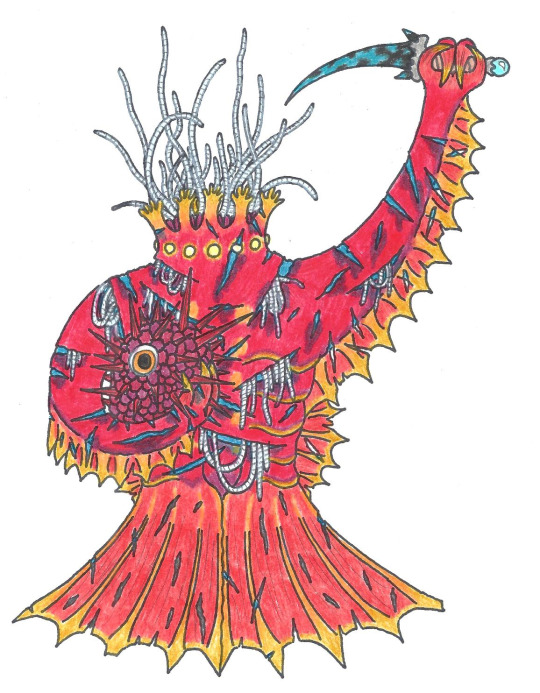
From the abyss comes the strange and the faithful, creatures of the deep born in a world of dark and prayer. Who they truly are and what they seek with the dry land above is unknown, as all that has been found is mere glimpses. Their carved relics grant images that cannot be fully understood, and their writings are in a tongue that cannot be deciphered. Corpses washed upon the shores allow insight into anatomy and flesh, but little on the mind and faith. Even those who are snared in nets or slither out from the surf under their own volition have little to truly say. Words can be spoken, but human ears fail to understand while the mind is left only with feelings and visions. Thankfully, many are those of peace, pilgrims or sages, coming to seek truths or dispense mysterious wisdom. Though alien they are, their faith brings familiarity, and it appears to protect all with a vow of non-violence (unless pushed to self defense). They bring prayer, blessings and trinkets with them, and share this strange bounty with those above. However, faith has many ways to show itself, and not all pray with song and tome....
The ones who wander the shores, lost in their chants and fervor, do not come bearing gifts and advice. They do not even seem to come here in search of terrestrial treasures or knowledge. Instead, their pilgrimage is something found only within, and it appears the coastal lands is where they set the stage. Unlike Monks, they do not go far inland, sticking close to water and home. They shuffle across the sands, hunched and murmuring, almost oblivious to everyone else around them. They clutch blade and spines in hand, often frightening those who witness them. Are these more warriors born in the deep, coming to punish our world for our sin? In one hand, a blade of ancient abyssal tooth, hardened by time yet not rendered dull by its passing. In the other, a living ball of spine and scale, writhing and watching. These are fearsome and unsettling tools indeed, yet they are not presented as weapons. Instead, it seems their cruel bite is saved only for this reverent being.
As they wander and chant, their knife slides across their hardened hide, opening crimson skin into Blue Blood and cerulean flesh. Some cuts are shallow, while others carve deep, yet they do not falter or hesitate. Even as odd stringy organs spill from their gashes, they keep to their prayers. The twitching ball of spines in their other hand pulses and stabs, yet they clutch it faithfully. They cling and cradle it, driving its spikes deeper into their own flesh, so more wounds may appear. But no matter how badly they bleed and weep, they stick fiercely to their faith. For that reason, these creatures have been labeled the "Penitent," for their worship is given through wound and pain.
Not much has been pulled from these Penitent, be it their reasons or wants. Their tongue is unknown, and they do not seem eager to communicate with others. Approach one, and they hardly take notice, obsessing over their blade and Blue Blood. It seems their own pain and cutting is how they practice their faith, and they have come to this inhospitable land to further pray in suffering. Though this world is certainly open to granting these Penitent more agony, they are not pilgrims to be trifled with. Their hide is much hardier than one can imagine, attesting to how sharp their blade is. Terrestrial weapons do little harm to them, and their tolerance to pain means they don't even flinch to even the mightiest of blows. No matter how many strikes are landed upon their flesh, the chanting continues. Even if one were to score a damaging blow, the reward would be a glut of Blue Blood and sizzling tendrils. The fluids that spill from their wounds are toxic and charged with Abyssal Lightning, turning a simple bloody splash into a dangerous weapon. Attacking them only creates more danger, and it agitates them. Trying to interrupt their prayer seems to whip them into a state of religious fervor, and their cuttings grow more wild. Perhaps they believe they are being tested, and thus more wounds are needed. And thus, more blood and organ is sent flying, coating the land in toxic fluids and crackling energy.
Pain is their prayer, and suffering is their song. If what they seek in their faith is atonement through agony, then it is no wonder they have come to this world of madness...
-----------------------------------------
"Penitent of the Sea"
One last aquatic thing before the month ends! I know I should have ended it off with the Mother of Snow, but couldn't help but want to slip one last thing in!
21 notes
·
View notes
Text
Goal List
One time goals
Get an offer of 55-60k for my first UX Job
Save up to 10k personally
Buy my own apartment in NYC
Buy a french chalet
Update my portfolio website to a cleaner/minimal structure
Create new presentation slides for the last two case studies
Finish designing website project
Move
Buy
An iPad air & apple pencil ($607.00)
New wardrobe (minimal, statement, with a glamour flare, maybe eclectic)
Kate Spade Nicola twist lock bag pink faux fur ($300) (I think the bag is discontinued because I can NOT find it, it's been years ;A;)
MyHeritage full edition ($29)
Figure drawing classes ($30)
Plans/Creations
Open an LLC for freelancing work
Plan out and create content for TikTok, Instagram, and youtube
Plan occasional content for @loungelaughloveove tumblr
Skill Improvements
Language (practice german 10 mins a day, read up on basics of Hebrew)
UX|UI (learn about graphic designing, UX & UI methods via course videos and readings)
Career (Practice networking, interviewing, negotiations)
Plants (Learn about the care of plants I own)
Drawing | Illustration ( Practice anatomy 10-15 mins when able)
Habits
Drink water for the majority of the day and save room for one sweet drink (full fruit juice or iced tea)
Eat more greens and less red meat
Eat 3 meals a day
Exercise every day (start off with walking for 10-15 mins 3x a day)
Maintain hygiene (shower, freshen up, wash and moisturize face)
Read books that are educational & offer new perspectives ( about my race, culture, women, self-improvement, religion)
Check in with friends and family regularly (no waiting months in between to reach out & respond to messages, make the effort to listen intentionally and connect intentionally)
Be presentable when I go out, even if it's just a walk.
Start going out alone and exploring again
Get at least 7 hours of sleep
The list was structured @boujeeceo 's "Stop holding back. Be ambitious"
314 notes
·
View notes
Text
Recovered Footage [1]
-The video begins on an empty stage platform set up in a gymnasium, with seemingly young students chattering in the background. Behind the stage is a large white curtain in place of a projection screen. Within a few seconds, a young-looking woman walks up onto the stage, shaking hands with the Sign Interpreter as she passed him. She’s dressed professionally, in a sweater and dress pants under a white lab coat with a pink-and-purple Relic Featherfly pin on her pocket. The cuffs of her pants are rolled up to her knees to accommodate wolf-like legs and paws, and she has a wolf’s tail flicking slightly under the folds of the coat. She adjusts a small microphone clipped on her sweater as she reaches the center of the stage. She lifts her hands, calling between them-
“Good morning, kids!”
-The chatter quickly ceases, though at least half of the students shout ‘Good morning’ back. She chuckles and rests her hands on her hips-
“And a good morning it is! My name is Juno Lystebrack; I’m a pediatrician, which means I’m a doctor that specializes in working with kids like you. I’ll be your speaker for today’s Fae Anatomy presentation. I want to start by thanking all of you who signed up for our little workshop; a lot of the stuff my colleagues and I cover over the next week is pretty important stuff relating to a lot of you and your cultures. And even if you’re completely human, and it never relates to you at all, we’re grateful to have you. A lot of this won’t be expected knowledge until you’re in middle school at least, but we’re firm believers in making sure it’s accessible to you as early as possible.”
-She pulls a remote out of her pocket, a projection appears on the curtain behind her, and the slide advances to a simple list. She paces slowly back and forth along the length of the stage as she speaks-
“Right, down to business. We’re going to start this presentation by talking about a group that could include any one of you: Hexalians. As some of you may already know, we get our power from our Goddess, Hexalia, through her ‘Gift’. It’s a unique set of magical skills along with a handful of biological changes.”
-She suddenly stops, resting her hand dramatically on her face. Her tone becomes a bit exaggerated-
“Actually, before we get too far: In order to fully understand Hexalian ‘Biology’, there’s another creature on this list we need to mention first. I just can’t think of it… Does anybody know what the first Hexalians started out as?”
-She grins as the kids shout excitedly, her tail wagging slightly. She stands a bit taller, pointing up beyond the camera-
“You don’t have to shout, hon; my ears are pretty good.”
-She leans with one hand around her ear. The camera’s microphone just barely picks up a child calling to her, and her tail wags-
“That’s right, kiddo; Vampires! Good on ya. It’s true; the very first Hexalian was a vampire. In fact, he was a kid, just like you guys. Actually, probably a little older than you guys. Now, there’s a very long story about how and why everything went down. And while I think it’s a pretty cool story, Fae History and Culture is someone else’s lecture.”
-She slips her hands into her pockets as she starts to pace again-
“What you need to know is: Basically, our Goddess took the vampire’s power, and she built off of it. As I’m sure we all know, vampires drink blood. Their bodies process it like any other food, with the added bonus of it boosting their magic exponentially. Hexalia took this ability and, well, adjusted it a little to make her Gift. Just like vampires use blood for power, Hexalians use laughter. We have the passive ability to absorb the ‘energy’ created when people laugh and convert that directly into magic. Pretty powerful magic too if I can say so myself.
Now, I’m sure you’ve noticed that I keep saying things like ‘We have this’ or ‘Our Goddess’. I’ll spare you too much mystery: I am, in fact, Hexalian, so I can tell you firsthand where we get most of our magic~!”
-There’s a noticeable purple glow in her eyes, and she moves her hand as if she’s going to snap her fingers. The camera picks up some nervous laughter and protests. She laughs brightly before putting both hands in her pockets-
“Ooh, a lot of you already know your stuff! You can relax, guys, I’m not gonna do it. I see some confused faces though, so I’ll be nice. For those of you that don’t know, you may have heard the little playground rumors that go around at your age. Well, one of them is very true: Hexalians are, basically, tickle monsters.”
-There’s a mix of murmuring that the camera can’t really interpret. She chuckles, and her tail wags again-
“You can laugh, but life is about efficiency. And having a little fun once in a while, of course. Now, some of you might think to mention: ‘Dr. Juno, you don’t seem like a vampire.’. Well, first, I might say ‘What makes you think that?’”
-She walks in a short circle, glancing at her own tail and paws as a few giggles are picked up by the camera-
“But yes, obviously, I’m a werewolf. That doesn't mean I couldn’t be Hexalian. I said at the beginning that any one of you could be. Some of you might not even know it. And the reason that could be is the same way you and your siblings can get your mom’s nose or your dad’s hair or your grandpa’s eyes; the same way you can be part vampire if one of your parents is or isn’t one; and the same way you can be really good at magic if you come from a line of mages. Hexalian magic passes through bloodlines.
Some might call the biological changes from the Gift ‘subtle’, but make no mistake, they can affect you in some major ways beyond your magic. We will still start with a subtle one though: Hexalia’s Mark.”
-She searches for a button on the remote, glancing up at the curtain as the slide changes. There’s a sketch of a few heart-shaped symbols with subtle wolf prints inside of them-
“Hexalia’s Mark appears on your body when you become Hexalian. If you’re born Hexalian, the mark is usually faint, but it becomes fully visible by the time you’re two or three. We don’t fully understand everything about the Mark, especially in babies and toddlers, but there’s a lot of evidence that it forms based on the magic in your body. It becomes a sort of self-sustaining battery, if that makes sense. That up there is actually a drawing of my Mark. You wouldn’t be able to see it anyway since it’s actually on the bottoms of my feet. Quick bit of bonus information, though: when werewolves shift, their mark becomes pretty much invisible unless they have a powerful surge of magic use. Obviously, it’s still there; its effects are always active. And some people with strong magic senses claim they can still see them.
Anyway, back to the point. What makes this thing more than a flashy birthmark? …I’ll give it to ya straight, kids, it’s really ticklish.”
-She chuckles, shaking her head as the students murmur curiously-
“I’m not kidding, you guys! The Mark is always sensitive to touch. When you’re born with it, your body can adapt before you even need to think about it. But to those of you that consider becoming Hexalian in the future: this thing marks your most ticklish spot. In fact, reports suggest that it gets worse after the mark appears. So, y’know, pros and cons. We’ll wrap up this section with some rapid-fire interactions that Hexalia’s Mark—or her gift, technically—has with certain species.
I’ll start with werewolves, naturally; my area of expertise. It might already be common knowledge for you by now, but we have a sort of weakness to silver and anything made from it. And while you, like me, might think that being pierced with a silver bullet or dagger would ruin anybody’s day, werewolves have most of their abilities weakened if not completely lost during contact with silver things. Hexalia’s Gift helps you…let’s say ‘resist’ that kind of weakness. Now, silver can still hurt me; it’ll still take longer for me to heal any injuries made by silver items, but…Ah, here: if I get a paper cut, that’ll actually heal up completely within a couple of hours. Barely even hurts for a minute. If I got a cut the same size with, say, an old letter opener or something that happened to be made of silver, that won’t heal for about a day. With Hexalia’s Gift, that gets lowered by half, on average. Werewolves report anywhere from fifteen hours to as low as eight.
Vampires. Everyone knows they drink blood. Vampires, actually, might get the strongest benefits; the Gift was made for them, after all. If you are a vampire and Hexalian, you do not have to drink blood. Like, not at all. You still can, obviously, but Hexalian magic is an exact fit to fuel your powers especially. Some vampires and mixed folks still carry the genes that make them sensitive to sunlight. The Gift clears that up too. You’ll probably still hate hot weather, but the burning, completely gone.
Humans, actually, have given mixed results. Several reports suggest that they don’t need to sleep for as long as they used to. Some claim that they find themselves feeling less hungry. The magic heals them all faster, protects them. In short, your mileage would definitely vary, but downsides are few.”
-She turns to advance the slide, but she seems to pause. She sighs, touching the edge of the pin as she looks back to her audience-
“Actually, there is one. I know I said I’d move on, but I think I’d be doing you a disservice if I didn’t tell you.
Now, I can tell that many of you are Nonhumans or at the very least Mixed-Blooded. Many Fae “Type” creatures have a store of magic within them. Actually, we all do, if we practice magic enough. Those of you that fall into this group have likely been told already what happens if you let your magic run too low. You start to feel sort of sick, or tired, or even like you’re in pain.
Hexalians have… Well, they call it the Burden. Many people believe that it’s been ‘bred’ out through the centuries. Some say it’s a legend and never existed at all; something to deter people from becoming Hexalian back in those days. But there are still rare reports. Since it’s so easy for us to gain magic, we hardly ever see it. But, according to those reports, the Burden is something inside you. Attached to your Mark. If your magic ever runs too low, the Mark will essentially try to start feeding off of you. Hexalians can regain power through our own laughter, after all, but less so. It’s like if you’re starving, your body will pull nutrients from wherever it can.”
-There’s a pregnant hush in the room. She cringes a bit nervously-
“I…I’m sorry, you guys; I don’t mean to scare you! It’s just that magic is very…temperamental. We want to make sure that all of you are at least prepared for what your own bodies are capable of.”
-She looks around the audience. A smile slowly returning to her face as her tail flicks-
“Okay, now, for real this time. Done with Hexalians. Let’s transition smoothly into Va—”
[FILE CORRUPTION ENCOUNTERED; ATTEMPTING RESTART]
[SUPPLEMENTAL FOOTAGE 8746; REGARDING T0C8E0J1SB3U8]
3 notes
·
View notes
Text
The transphobes’ understanding of womanhood was created by sexist men in the 19th century

Alokvmemnon has presented a great slide show over at Instagram looking into the history of science and how attempts at defining womanhood have aimed at keeping women in check.
As we celebrate the International Women’s Day, this can serve as a reminder of how oppressive narratives do not appear out of nowhere.
The series is based on the book Sexual Science: The Victorian Construction of Womanhood by Dr. Cynthia Russett (Harvard University Press 1991)


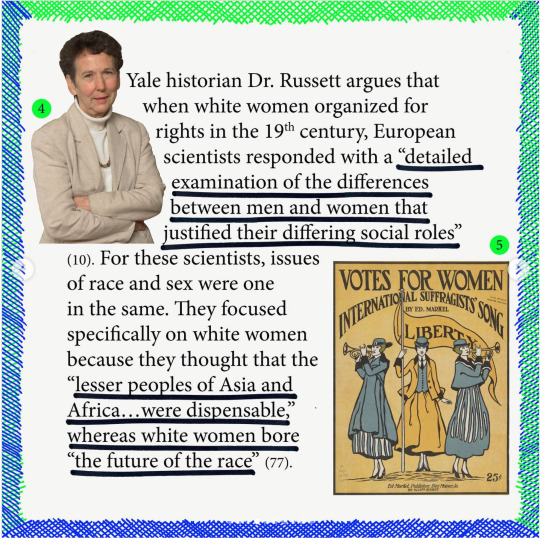

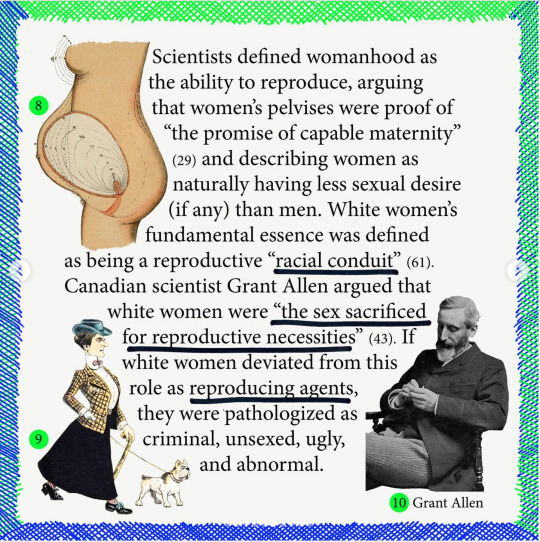




TRANSCRIPT
//Often people refuse to accept trans women as women by weaponizing the idea of "biological sex.” They argue that trans women are not women because they are incapable of giving birth like "biological females." They conveniently forget how "biological sex" is a framework that was created by white male scientists in the 19th century specifically to justify discrimination against white women and Black people, Indigenous people, and people of color (BIPOC).
Yale historian Dr. Russet argues that when white women organized for rights in the 19th century, European scientists responded with a "detailed examination of the differences between men and women that justified their differing social roles". For these scientists, issues of race and sex were one and the same. 'They focused specifically on white women because they thought that the "lesser peoples of Asia and Africa.. were dispensable whereas white women bore "the future of the race"
After Darwin's theory of evolution, white male scientists doubled-down on their efforts to deny white women an equal role in society, inserting white women and BIPOC people between themselves and apes in a fabricated racial evolutionary continuum. 'They argued that women were' "inherently different from men in their anatomy, physiology, temperament, and intellect." and that white women "lagged behind men, much as primitive people lagged behind Europeans" in the civilizational hierarchy. German scientist Carl Vogt argued that white women's skulls resembled Black people's skulls more than those of white men. While white men were seen as unique and distinct from one another, white women were seen as "more generic and less specific".
Scientists defined womanhood as the ability to reproduce, arguing that women's pelvises were proof of "the promise of capable maternity" and describing women as naturally having less sexual desire (if any) than men. White women's fundamental essence was defined as being a reproductive "racial conduit". Canadian scientist Grant Allen argued that white women were "the sex sacrificed for reproductive necessities". If white women deviated from this role as reproducing agents, they were pathologized as criminal, unsexed, ugly, and abnormal.
Social Darwinist Herbert Spencer argued that confining women at home and preventing them from working was the "touchstone of high civilization," unlike Indigenous and Black communities where women worked. Scientists believed that white women couldn't receive an education or work, because they would lose vital energy that was reserved for reproduction. Ely Van de Warker called this the "penalty of sex" and Herbert Spencer called it "the physical tax which reproduction necessitates." European male scientists concluded that the primary role of white women was to mother, that she had no other "gift to offer but her healthy - and numerous - offspring.
European scientists leveraged the rhetoric of "biology" to naturalize discrimination against women. This wasn't legitimate science based on "reliable data;" instead it was often discussed in their research as "common knowledge". By defining women's whole being and purpose as reproductive, they were able to justify denying women's suffrage and women's mobility as a law of nature, not the result of political choices. Unfortunately, centuries later people continue to use the rhetoric of science - and not the reality of science - to justify discrimination against trans trans and intersex people.
It's not science to define womanhood solely by genitalia and reproduction, it's sexism. Womanhood is far more complex and expansive than the ability to give birth.//
Source: Alokvmenon on Instagram.
#trans#transgender#feminism#sexism#lgbt#lgbtqa#terf#gender critical#woman#international women's day#transphobia#history
37 notes
·
View notes
Note
Oh my god please discuss the sliding scale of personhood autobot vs decepticon in the Bay movies it sounds genuinely fascinating
Okay. So. Full disclaimer, it's been a while since I sat down and dedicatedly rewatched Bayverse- I keep meaning to and then getting confronted with the slap in the face that is actually having to do it, so. This is by necessity going to talk only in broad strokes, plus you should take it with a pinch of salt or ten since my memory is a crapshoot tbh. But hey ho!
The Decepticons are interesting because they move quite freely, depending on the character, film and even moment, between a wider range of 'is this a person?' compared to the Autobots. The Autobots have two main modes: people that are mostly comparable to humans (however flat and uncared for by the narrative) and beloved, domesticated animal (again: the boy and his car-dog thing, this is mostly just Bee's role).
The Decepticons might include depictions of them as, in any given film: a person who is thoroughly Othered from human people in some capacity, a monster, also some kind of domesticated pet or creature (spoiler: that's Wheelie), or something pretending to be a person. Let's go over some of why that is, and how Bayverse creates such a stark contrast between the two factions as compared to something like G1.
The designs are the most obvious thing to point to here. People often deride Bayverse's designs as universally incomprehensible, but this elides the fact that the Decepticon designs are very clearly intended to be more incomprehensible visually. They are often more alien, less humanoid or humanlike, and less conventionally appealing than the Autobots. Indeed, I've said before that I tend to prefer the Decepticon designs in Bayverse because they lean much further into the aesthetic of noise and weirdness, and this makes it feel more like a choice; but that's not a neutral coincidence! They are designed in ways that adhere to common wisdom about what makes a character design 'appealing' or 'unappealing', what is used to present characters as 'relatable' or 'not relatable' inhuman characters to an audience of humans with certain assumed biases.
Compare 2007 Optimus and Bee to Megatron and Starscream, for example:

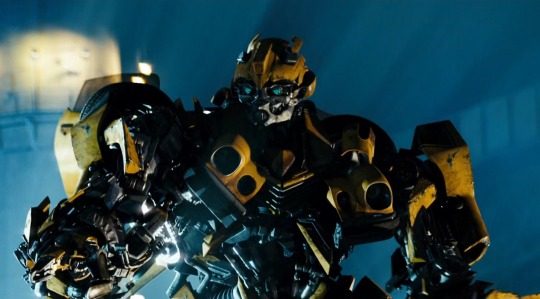

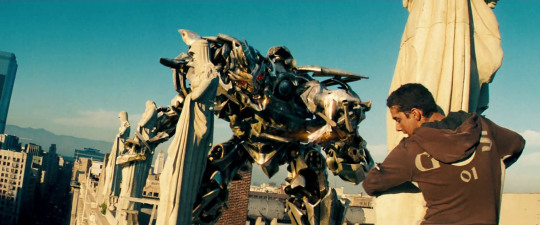

Broadly speaking, OP and Bee, even with all the over-engineered noise of their designs, have clear, recognisable faces that draw your attention to the eyes. Optimus' design sits as the most humanlike, with Bee's divergence from standard human faces primarily drawing attention to his muteness (which we discussed previously) with the 'gag' where his mouth might be.
Starscream, meanwhile, is more obviously inhuman by a wide margin. He has a bird face- he is explicitly animalistic! Why doesn't Starscream mirror his G1 design even a little when OP and Bee do? Partly it's because one goal of the design choices here are to make the Decepticons seem monstrous in a way which more clearly delineates the two sides than the G1 designs do. Megatron is not nearly so specific in what he evokes, but looking at him side by side with the Autobot designs, you can see how it carries over. He is broadly humanoid but lacks a lot of the definition that gives Bee and OP a more humanlike apperance, in part due to how his being monochrome makes him seem less clearly in possession of a humanlike anatomy (Bee has pecs!), plus his eyes are small and set far apart in a way that evokes certain types of animal skull. And like. He's got "horns", haha. THAT TOO. Not subtle.
But Megatron and Starscream are both shown to be intelligent, of course. They speak, they communicate, they are not shown as beasts even as their designs evoke a more monstrous affect to distance them from our human baseline. They possess some degree of personhood in how they are presented (it makes for better central villains!). But it's a personhood a few steps further removed from human personhood than, say, Optimus'. The Decepticons have (scary, inhuman) people among them- but they are not exclusively, or even mostly, made up of people the way the Autobots tend to be presented.
Moving along the line. Another Decepticon is Wheelie, who is shown in a similar way to how Bumblebee is- like a kind of super-pet, the fantasy of having a cool robot who's smart enough to communicate with you but who is still, well, your pet. His design is obviously very far from humanlike, though as he's intended to be endearing (theoretically) rather than menacing, his design more like a harmless spindly bug than a 'monster'. Bigger eyes in a deeply inhuman face: that's not a person, that's a pet that can talk to you, the movie says! Imagine, a dog that humps your leg and makes really awful sex jokes. What a dream.

He arguably follows on from a template that Frenzy established the movie before, where Frenzy was presented like his undomesticated equivalent in this uncomfortable analogy. Their designs evoke similarly inhuman vibes, where the influence is insectoid and therefore unpleasant but not super menacing. Compare the slapstick way violence against Frenzy is framed versus how even unsympathetic characters like Starscream tend to be shown in fights- it's implicitly just not violence being done against a person as opposed to like... a cockroach that learned to talk. Again: he's visually further than any Autobot from human by a significant degree, and he exists on a different narrative level than Decepticons like Megatron. In universe, no difference; but to the audience there sure is.

Then we have the ones that are just... monsters of a very beastly variety. I'd argue Barricade in the 2007 movie fits this despite ostensibly talking and showing humanlike intelligence; he speaks very differently to like, Megatron, for example, all brusque repetition that doesn't evoke someone who's done more than memorize the question, and throughout his big 2007 setpiece he's then basically treated like a predatory animal; largely silent beyond his couple memetic lines, seeming too intelligent for his form at times when we see him in alt (his alt mode being so prominent in creating paranoia really mirrors the idea of an animal stalking its prey IMO, and how scared we are when animals seem to display uncanny-to-us intelligence and thought). Barricade is not a person to be fought, he's a hunting dog let loose, the framing suggests, and the goal is to put him down before he tears out your throat. He's a good example, I think, of a single character moving between modes within a single film. He has a brief moment of personhood (for gag purposes) but easily reverts to that predator-animal template. Decepticons can be wild animals too, then.
Even further along that axis is something like Revenge of the Fallen's Devastator. That's just a big scary monster, y'all! Look at it! RotF as a film is not interested at all in the implications that this is a combiner, let's be real, so we will also put that to one side and not come up with some bullshit about how 'maybe it's because he's a combiner', like let's be real guys, RotF isn't bothering with that thematic stuff. It's RotF, that movie is so goddamn dumb. Anyway. So this:
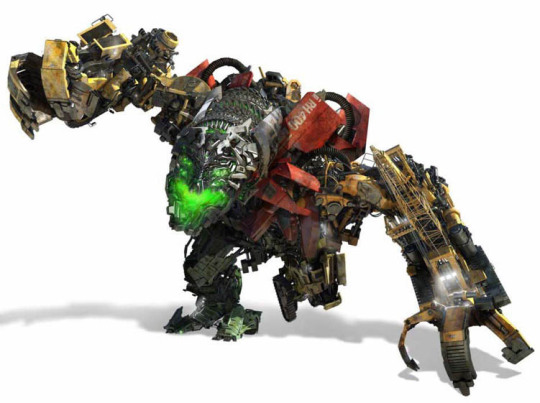
This is a monster, not a person; that face is a maw, not a face. Proportions are all weird and truly animal-like too. A speechless, destructive monster who exists less as a person to fight and more a natural disaster to resist; and another type of Decepticon that will not find an Autobot counterpart, because Autobots are people bar a couple domesticated exceptions, but Decepticons go all over the conceptual map, with this as an extreme!
And the whole idea that a Decepticon that is not a person might be mistaken for one is of course then used for horror at one point. When we see Alice the pretender, the fear comes from how convincingly she apes being what she is not: a human yes, but also a thinking, feeling person of any description. Her true form is partly creepy for having a bunch of unnecessarily humanlike features warped into something grotesque, and does not speak after she's revealed I think. My point is that the scary part of Alice is that idea of mimicry that can't be detected, and oh boy oh boy is there some fucking subtext to that scene we could read into it. By the way. Remember how there's an implicit dick joke and oh god RotF is a godawful film I hate it so much. I know you all know this, but I do. ANYWAY. I think she'll round out our trip down the 'scale' for now.
The above is in no way comprehensive (and leans real heavily on the first two films- there's actually potentially some interesting stuff about how Megatron, specifically, changes in how he is framed going on, and arguably becomes at one point the only truly personified Decepticon character). I haven't even found a place to get into how yes, the reproductive cycle stuff theoretically applies to all Cybertronians but is only ever shown when the Decepticons are doing it, and is notoriously weirdly animalistic and visceral; they have like, egg sacs, they have a very organic but very inhuman and upsetting life cycle thing going on with their babies and all. This is extremely scattershot! And missing stuff and possibly at points a bit off base because again, I'm running off my memory here. But I hope it shows a bit of how and why the spectrum of 'person or not' is a much broader question for bayverse Decepticons than Autobots, and how it often skews further to the 'not' side by a wide margin.
And it's also very all over the place in terms of the resulting implications. Some of it has its roots in very charged stuff; some of it could be read a multitude of ways! Where the Bee post is more clearly a matter of 'here is how casual ableist assumptions play out in Hollywood blockbusters without thinking', this is a wild combo of everything from 'here's how they reverse engineered transmisogyny' to 'here's why cannon fodder in dumb action flicks is designed like this so often'... but there, assumptions about 'appealing character design' are not politically neutral. (Take the old 'bigger eyes are always the more appealing option!' thing, that's a culturally specific assumption that has all sorts of follow on discussions about orientalism, for example.) The whole thing tends back towards something reactionary at basically every turn, though the 'what' might vary.
But ultimately I think the takeaway is: the bayverse films set you against the Decepticons not through obvious ideology- I doubt anyone got a coherent idea of their aims or anything out of the movies- but by sliding the scale down to 'not human' in many ways and letting our brains fill in the rest.
43 notes
·
View notes
Note
i just want you to know that the omegaverse au has been living rent-free in my head. karkat would be Such a good alpha. i'm also finding it interesting that you're doing it with a pack structure rather than as a thinly veiled gender-analogue (no shade, i've done the latter often enough) - what do the different roles mean to you, if you wanna share?
where is that gif of the guy sweating profusely, that's me rn
Yeah I never vibed with the "second gender" thing. (No shade here either, I have sure READ it!) An old old old friend came up with the term "endotype" so that's what I go with and that's the vibe. And the roles are kind of more flexible in my system because the endotype is a spectrum.
The core of the concept is that you have a spectrum with Omega on one side and Alpha on the other and Beta dead center, but it's not a trinary system. It's more common to be somewhere between Beta and Alpha/Omega than to be Just Alpha/Beta/Omega. Though "True" A/B/Os do exist. Given how it works, they may slide on the spectrum over time though.
Okay one fun detail from this AU: Dirk has a fairly rare condition that causes his endotype to yo-yo between Alpha and Omega pretty regularly. Instead of a slow year or years long process, Dirk will wake up one day like "..... aw fuck" and know he's sliding the other way again, and in like a month or two his endotype will flip. He finds it really annoying. Jake is very sympathetic but deep down is fistpumping bc it means Jake gets whatever he wants. The universe bends to Jake English's whims, even in AUs.
I have yet to nail down how I want endotype to manifest anatomically. I'm not personally vibing with the idea of "male omega and female omega are different" so perhaps endotype is linked to anatomy while your gender is... just your gender. It's presentation and choice above all else? Maybe.
As far as roles, these are BROAD STEREOTYPES but:
Alphas: The Service Top endotype. Alphas are predisposed to taking care of everyone around them and seek to create emotional harmony and prioritize what's best for the group. They can be depended on to do tasks for pack cohesion but aren't as comfortable making decisions. Carrying out decisions, awesome, cool, but they are the person who will drive everyone out to dinner but do not ask them to choose where to go, for god's sake.
Omegas: The Soft Power Boss endotype. Omegas are the territorial ones, they want things a certain way and prioritize direction. They're super aware of the emotions going on around them and will poke and prod things to go their way. They will choose where the pack is having dinner, and everyone is relieved someone here can make a fucking decision. A pack without omegas or low betas would lack direction probably.
Betas: Middle of the road! Most betas are close to one of the two sides of the spectrum, so inherit traits from that side. A True Beta so to speak functions best on their own, getting shit done. Best example: Roxy, in my AU, is a true Beta, and she and Dirk trade off being the pack leader, but Roxy is also the main breadwinner for the pack with a really lucrative programming job, and having the thing she contributes the most be not linked to pack cohesion makes her happy. She'd LOVE to rope someone else into being Pack Leader already, god, its so exhausting.
jfc there's a BUNCH OF THOUGHTS. goddamn.
47 notes
·
View notes
Text
The iPad Kid In Question
In today's generation, the concept of "iPad kids" has gained popularity as a meme and cultural reference. It represents a generation of youngsters who have grown up surrounded by technology, specifically tablets like the iPad. It was an ongoing meme that can be coined as an insult that led me to deny that I am not an iPad kid. However, with how I deal with everyday life, I’ve realized that I cannot live without it. The iPad has played an important role in my life, especially in my academics and leisure activities.
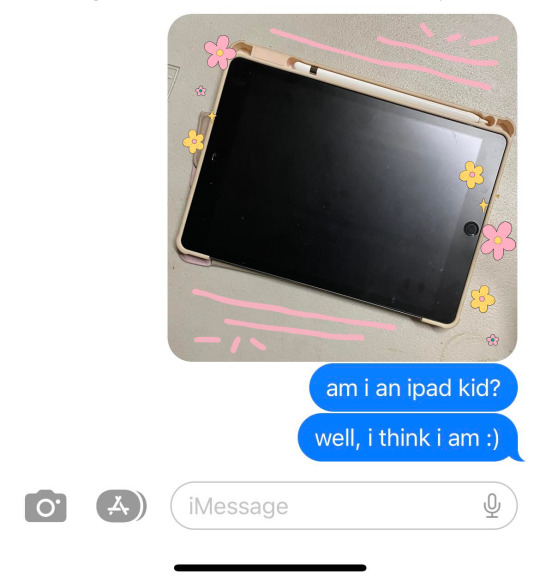
Do I need my traditional nursing books? No, I have already downloaded them to my note-taking app (Goodnotes). I do not need to bring my thick nursing books to school because I have everything downloaded on my iPad. Do I need to bring tons of notebooks or pad paper when note-taking during lectures? No, I do not need to because I have a handy dandy iPad with me when I go to school.


One of the most significant advantages of utilizing an iPad for taking notes is its portability. iPads are lightweight and compact, allowing me to easily carry them wherever I go. Whether in a classroom, group meeting, or coffee shop, the iPad offers a convenient device for taking notes on the go without the need for heavy notebooks or stacks of paper. iPads also save notes digitally, removing the need for physical storage and minimizing clutter. I do not need to be stressed whenever I cannot find a certain reviewer of mine that I need to use to study for a quiz the next day. Moreover, I can organize my notes into folders, categories, or tags, making it simple to find specific information quickly and therefore saving me time and effort.

Aside from note-taking and storing my books, I can access a lot more websites and apps that are needed for my academic requirements. Apps like Quizlet and Anki, which I use for reviewing, especially for active recall and spaced repetitions, allow me to create custom flashcards using text, graphics, music, and even mathematical equations that fit my learning style. They include multimedia features to improve my retention. These kinds of apps are really helpful for me since nursing is a course that demands a lot of memorization of different concepts. They are my lifesaver when memorizing key terms, medical terminology, anatomy, pharmacology, and other nursing concepts.

Canva is also an app that helps me survive school, and without it, my non-creative self cannot live in the academic realm wherein creativity is a required skill in creating and finishing schoolwork. The ready-made presentations, infographics, posters, and other forms of media help me meet school deadlines. I still tweak its design, but the fact that there is a template that I can use as a guide makes me more productive. Regardless of background or expertise, a person can create graphic designs using the straightforward drag-and-drop interface and pre-designed templates of Canva.

Another app that is helpful in terms of video editing because of how accessible it is and easy to navigate is Capcut. It is an app that both my iPad and phone can access, making video editing for school tasks easier than before. The interface is well-organized, with tools and features that are easy to access and use, allowing me to efficiently edit videos without being overwhelmed by complex settings. CapCut provides a comprehensive range of editing tools and features that allow me to modify and enhance videos based on my preferences and the requirements of my subjects. When I was in high school, I needed to borrow my mother’s laptop to edit in a built-in video editing app that was hard to navigate because of its technicality and complicated interface. But with this particular app, I can finish my work within a small amount of time, which I can say is perfect for a student who crams video-type projects.
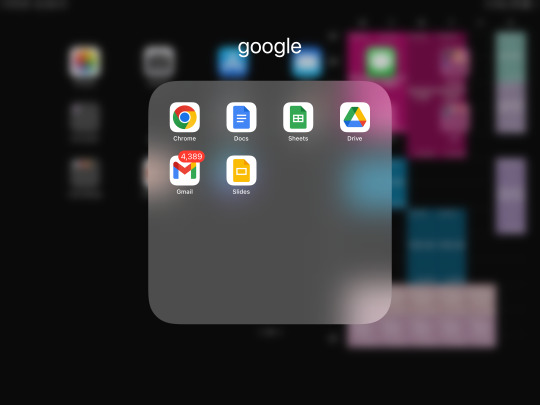
Google apps like Google Meet, Google Slides, Sheets, Drawings, and most especially Google Docs, have made my life easier. With just having a Gmail account, I can access my documents on all of my devices. If I forget to add something to my document and I already closed my laptop, I can use my iPad or phone to add more information to my paper without the need to assemble my laptop, especially when I’m already lying down in bed ready to sleep. If there is an urgent need to revise my work but I’m out of the house and do not have my laptop with me, I can use my iPad or even my phone and edit it through the Google apps. With an Internet connection, these apps or websites bring convenience and accessibility wherever I go or whatever circumstances I have.
Google Docs, Sheets, and Slides also allow multiple users to work on the same document at once. This real-time collaboration function is especially useful for group projects, team meetings, and collaborative writing assignments. I can monitor changes and updates in real-time, thereby facilitating seamless communication and workflow efficiency. I also consider this a lifesaver to pinpoint my groupmates who have been neglecting group tasks and monitoring their contributions.
Moreover, the nerve-wracking experience of accidentally deleting one’s document is devastating and something I do not like to experience again. Google Apps are a lifesaver again in this aspect because they automatically save versions of documents, allowing me to track changes, return to previous versions, and discover who made specific modifications.
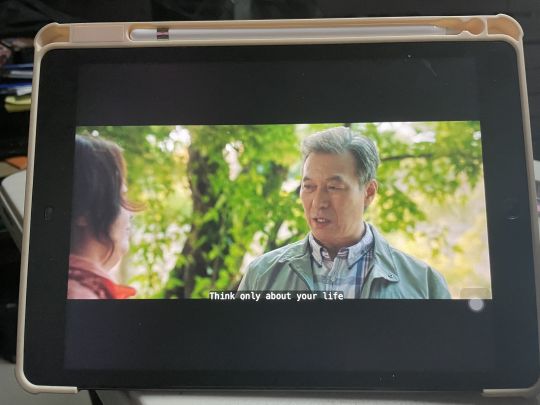
Last but not least, my favorite feature of the iPad is its size and how I can watch series and movies on a larger screen. I do not like the hassle of turning on my TV or my laptop, both of which I cannot bring to my bed whenever I need to rest. With the iPad, there is unlimited access to watching shows while lying comfortably in my bed. I have access to a vast library of movies, TV shows, documentaries, and original content, allowing me to explore a world of entertainment possibilities at any time and from any location. On top of that, I find it difficult to refrain from eating without watching something on my iPad. This behavior perfectly aligns with the concept of an 'iPad kid,' someone who eats while using their iPad. It is essential for me when I eat since if I do not distract myself through watching videos, I tend to eat too fast, therefore not being able to chew my food well.
Besides what I've mentioned above, the iPad's multitasking capabilities also enable me to view videos while also browsing the web, reading emails, or taking notes. Picture-in-Picture mode allows me to minimize the video player and continue watching content while using other programs, thereby increasing my productivity and multitasking effectiveness. I particularly enjoy this feature when I just need white noise or background noise whenever I need to finish something that does not require too much work or concentration. In addition, this feature is also useful whenever I need to write down notes during my online classes.
"my lifesaver"
My phone and laptop have features and strengths that I use depending on what I need, but my iPad is a mixture of them. With the help of my Apple Pencil, offers versatile features that make my life more productive. The iPad's combination of features and characteristics provides versatility and adaptation to various demands and preferences. Whether I use it for work, play, education, or creativity, the iPad is a versatile platform that adapts to my changing needs and lifestyle. At this point, I can say that I’ve already achieved a return on investment, or ROI, with my iPad.
A phrase that can describe the technology, in general, is ‘my lifesaver’. Throughout my narrative, I cannot count how many times I mentioned that phrase because indeed, these smart devices, digital services, and software applications offer convenience and accessibility that make life easier. They provide unprecedented convenience and accessibility in our daily lives. Whether it's ordering food online, booking transportation, or operating smart home gadgets with voice commands, technology makes tasks and routines easier, saving time and effort. As we manage the complicated aspects of modern life, technology is our constant friend, allowing us to prosper in an ever-changing digital landscape.
2 notes
·
View notes
Text
today is a day for making french onion soup, doing laundry, creating presentation slides that detail the muscle anatomy of some figure skaters legs, etc
12 notes
·
View notes
Text
What is the new speak word for ass? As in Dr Ilana Sherer should pull her head out of her ass? Because no self respecting woman is calling her clitoris a "dicklet"
Prominent doctor at the American Academy of Pediatrics proposes renaming penises 'outies', vaginas 'front holes' and clitorises 'd*cklets'
Dr Ilana Sherer is a pediatrician from California who providers transgender care
She gave a presentation at the AAP National Conference in Washington, DC
READ MORE: Academy of Pediatrics backs transgender care for minors
By ALEXA LARDIERI U.S. DEPUTY HEALTH EDITOR DAILYMAIL.COM
PUBLISHED: 14:46 EDT, 23 October 2023 | UPDATED: 05:03 EDT, 24 October 2023
A top pediatrician has called for child doctors to start calling the vagina a 'front hole' and the penis an 'outie.'
Dr Ilana Sherer, a pediatrician in Dublin, California, gave a presentation Sunday at the American Academy of Pediatrics (AAP) National Conference and Exhibition and called for more gender neutral terminology for body parts.
Her proposals, given during a workshop entitled 'Discussing Gender and Sexuality in the Primary Care Office,' included referring to the vagina as an 'innie,' 'front hole,' or 'T-penis' and the clitoris as 'd*ck' or 'd*cklet.'
She also proposed calling breasts 'chest' or 'chesticles.' For male anatomy, Dr Sherer recommended pediatricians call the penis 'outie,' 'junk,' 'strapless,' or 'bits.'


e-mail
Top
+99Home
614
View comments
A top pediatrician has called for child doctors to start calling the vagina a 'front hole' and the penis an 'outie.'

ADVERTISEMENT
Dr Ilana Sherer, a pediatrician in Dublin, California, gave a presentation Sunday at the American Academy of Pediatrics (AAP) National Conference and Exhibition and called for more gender neutral terminology for body parts.
Her proposals, given during a workshop entitled 'Discussing Gender and Sexuality in the Primary Care Office,' included referring to the vagina as an 'innie,' 'front hole,' or 'T-penis' and the clitoris as 'd*ck' or 'd*cklet.'

She also proposed calling breasts 'chest' or 'chesticles.' For male anatomy, Dr Sherer recommended pediatricians call the penis 'outie,' 'junk,' 'strapless,' or 'bits.'
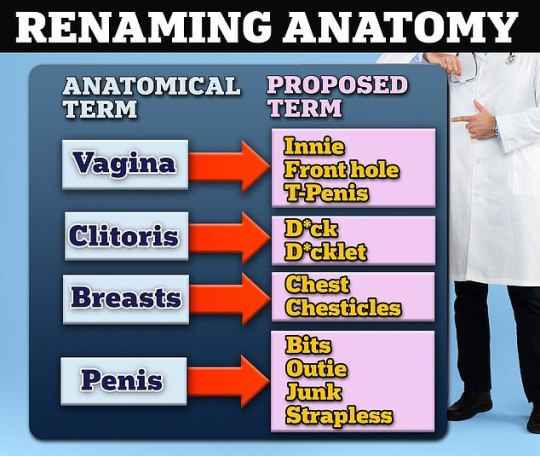
+5
View gallery
Pediatrician Dr Ilana Sherer gave a presentation at the American Academy of Pediatrics National Conference and Exhibition and called for more gender neutral terminology for body parts

Slides from Dr Ilana Sherer's presentation offer advice on how to talk to pediatric patients about gender and sexual identity, including new terms to use to address genitalia
Dr Sherer is a general pediatrician at Palo Alto Medical Foundation/Sutter Health.
She is board certified by the AAP, an organization to advance child health and well-being, as well as the profession of pediatrics, and serves on the organization's Executive Committee for LGBTQ Health and Wellness.
Some in the medical community have been calling for gender-neutral body terminology for years, recommending 'upper body' for breasts, 'erectile tissue' for penis and 'internal gonads' for ovaries.
They argue it creates a more inclusive space for people who may not identify as one gender or sex and are not comfortable using gender-specific terminology.
But doctors have previously warned against politicizing medical language because it could confuse public health messaging, especially for people for whom English is not their first language.
Dr Leonora Regenstreif, a family physician in Canada, told DailyMail.com: 'Health providers don't need to be "cool." We can just politely and respectfully use clinical, anatomical language.
'Kids might giggle or snicker but they will likely be even more put off if we try to "match" their word choices, which may be based on pornographic or inappropriate online resources.'
The physician said a few questions, modified for the age of the patient, like 'are you sexually active?' and 'Have you had intercourse with someone with a penis?' are adequate.
She added: 'Any more detail than this - like suggesting novel words like "front-hole" or "dicklet" - are unnecessary and prurient.'
Furthermore, Dr Julia Mason, a pediatrician in California, told DailyMail.com: 'I am concerned that pediatricians are encouraging dissociation from young people's sexed bodies in the doctor's office, where terms need to be simple and clear.'
Dr Mason added that during Dr Sherer's presentation, she noted rates of unintended pregnancy are high among girls who identify as lesbians.
'I worry about kids being provided with incomplete information, leading to uninformed behavior and unintended consequences,' Dr Mason said.

Dr Ilana Sherer is a general pediatrician at Palo Alto Medical Foundation/Sutter Health in Dublin, California
During her presentation at the AAP Conference, Dr Sherer was not speaking on behalf of the organization and her recommendations have not been adopted or implemented by the medical organization. The AAP has not commented on Dr Sherer's presentation.
When it comes to LGBTQ care, in 2021, the AAP advised doctors treating patients identifying as transgender to ask them what words they would like used when referring to various body parts.
Guidance from July 2022 instructs parents to use 'correct names for body parts' when talking to young children and discussing body development and sexuality.
In August, the AAP voted to stand by its 2018 guidance that supports LGBTQ access to counseling, hormone therapy, puberty blockers and, occasionally, surgery for minors under 18 years old.
Any guidance from the AAP is not binding for doctors, but advice announced by a prominent medical advisory body is often implemented by healthcare providers as best practices.
In trans girls, options include tucking male genital with medical tape or specialized underwear and padding with breast forms of silicone gel, padded bras and padded underwear to accentuate the hips and butt. Additional options include vocal training, makeup tutorials and wigs.
In trans boys, options include binders like compression garments, and 'packing,' which includes a penile prosthesis and a 'stand to pee device.'
A medical option includes prescribing birth control to patients who are menstruating, which will stop them from their getting periods.
Other points of Dr Sherer's presentation outlined potential 'non pharmacologic treatment for body dysphoria' for trans girls and trans boys.
Dr Sherer's presentation also outlined how to ask patients about gender, including asking their preferred pronouns, gender identity and sexual orientation, and if they identify as male or female, or neither.
To get more information on a child's sexual orientation, Dr Sherer said doctors should ask patients if they are in an intimate relationship and what 'parts of your body do you use/have you used for sexual pleasure?
Other questions relate to monogamous relationships, previous and 'side' partners, the genders of a patient's partners and what body parts they use for sexual pleasure.


The California pediatrician's workshop also recommended doctors 'think about your office' and said they should display affirming signs and posters, ensure staff have adequate inclusivity training, hire a diverse staff that represents patient identities, have all-gender bathrooms, inclusive medical forms, include preferred pronouns on patient charts and display pronoun stickers on staff ID badges.
Similar recommendations were released by the AAP in June 2021.
The mission of the AAP is to 'attain optimal physical, mental, and social health and well-being for all infants, children, adolescents, and young adults.'
The mission continues: 'Children have optimal health and well-being and are valued by society. Academy members practice the highest quality health care and experience professional satisfaction and personal well-being.'
The medical care of trans patients has been politicized into a hot-button issue and is becoming a key political battleground heading into the 2024 Presidential Election.
Local and national politicians have been fighting and enacting legislation that limits and even outlaws gender-affirming care for trans children, which can include hormone therapy, puberty blockers and genital reconstruction.
Up until the wave of state bans began in 2020 and 2021, there were no restrictions at the federal level for access to these treatments, which in some cases are irreversible.
However, as of May 2023, 20 states have enacted legislation, executive actions, or other policies that restrict or ban healthcare for transgender youths, and more than 100 additional bills are under consideration.
All of the states are Republican or Republican-leaning, and all but one voted for former President Donald Trump in the 2020 election.
Much of the political debate in recent years has been amid concerns that minors who get gender-affirming care are too young to make such a life-changing decision and are not fully aware of the risks.
For example, studies suggest those who are transgender are six times more likely to suffer from autism, and up to 70 percent of trans youths are depressed.
Other studies, including one by the National Institutes of Health, suggest patients are happier after the surgery, further complicating the issue.
There are concerns among Republican lawmakers about the lack of long-term safety data on puberty blockers and hormone drugs, which have seen other countries like the UK and Scandinavia restrict access in minors.
The Food and Drug Administration approved puberty blockers 30 years ago to treat children with precocious puberty - a condition that causes sexual development to begin much earlier than usual.
Sex hormones - synthetic forms of estrogen and testosterone - were approved decades ago to treat hormone disorders or as birth control pills.
The FDA has not approved the medications specifically to treat gender-questioning youth, but they have been used for many years for that purpose 'off label.'
Doctors who treat transgender patients say those decades of use are proof the treatments are not experimental.
Dr Sherer and the AAP could not be reached for comment
#Dr Ilana Sherer#AAP National Conference#American Academy of Pediatrics (AAP)#'Discussing Gender and Sexuality in the Primary Care Office#Ok I can't argue with calling a penis junk#Executive Committee for LGBTQ Health and Wellness
2 notes
·
View notes
Text
SHOW OF THE CENTURY .

WARNING .
do not proceed if the following makes you queasy .
blood , medical malpractice , unlicensed medical procedures , live dissection , kidnapping , murder , torture , death .
these will be the only trigger warnings i have in place from here on out . this is the type of content you are being warned that i write .

the sound of footsteps reverberates off of the confines of metal walls, leather and metal clicking against polished concrete, accompanied by a jubilant hum of anticipation. oh, what a momentous occasion! one of the greatest performances will be exhibited tonight, all that the artist desires is for his audience to give him is utmost attention and utter silence, and to be revered and awed and bathed in the admiration the people have to give him.
that is the only price he asks for.
fingers gloved by black latex feel against the wall as he walks, reaching a risen plane and he flicks a switch on, spotlight shining down on a figure tied on a chair, writhing against the ropes that secure him in place. nearly nude, a dignity given only covering nether regions, blindfolded and gagged, legs tied onto legs, a perfect composition of a hostage in need of a savior.
there will be no savior. only a dead god whose gentle hands adore his subjects. “my beloved muse.. i hope you weren’t waiting too long.” a serene tone that did not reflect the severity of the situation. his beloved muse had been sitting, languishing away in the stygian atmosphere, no songs of comfort and no sound, no light, no life. nearly entombed in the house of steel. chamber approaches the bound man, fingers curling around a quivering chin as he tilts a teary-eyed face upwards to coo quietly, “how splendid you look. are these tears for me ? you’re so thoughtful. this is why i adore you.”
his free hand reaches down into a pouch, revealing a syringe as he lifts his hand to present it in front of wide eyes. “you have behaved well. let me give you a gift.” with a soft smile, chamber lowers the needle to a neck that would not stop moving, leading him to grasp onto hair roughly to keep that damned head in place as he injects his darling subject with a sedative.
a sedative that leaves the other conscious.
now, where should he begin ? the head. he tosses the hollow syringe aside ungracefully, glass shattering on the concrete, uncaring of the sharp mess it has made. his subject now sits limp, unmoving but seeing all, watching as chamber picks up an object from the floor. a metal rod with a design at the end — a brand. his free palm begins to glow as it generates high temperatures, and he presses the flat of the brand against the superheated surface, a hiss of steam when metal comes into contact.
only when the marksman acknowledges the metal illuminating does he lift the rod from his palm, hand cooling down as he busies himself with pressing the brand into his subject’s forehead, rising from skin to reveal that the branding is his own logo, the eye of the dead god. how fitting. how cruel. setting the brand aside, back onto the floor, he once again reaches back into the pouch he retrieved his initial syringe from and brandishes a scalpel.
he grasps one of the limp arms, letting the tip of the blade dig into skin, making a sliding motion to create a clean cut from wrist to forearm. methodically, he carves into the skin, lifting pieces off like if it were cured ham, as if he were planning to create a charcuterie board from skin shavings and tears of a poor sod. but it bores him, shortly after making a bleeding mess of an arm.
so he follows with the makeshift surgery.
carving into still flesh, the blade slides too smoothly through layers of skin and tissue, not yet breaching through to the body cavity as it glides over the center of a ribcage, down to the navel. then, the blade is lifted only to create parallel lines perpendicular to the initial cut, one atop the chest, one under the belly button. a wretched window to a grotesque fascination of discovering the human anatomy. he tilts the scalpel at an angle, now, slicing into the fascia, the connective tissue that separated outer flesh from the core, gently peeling the layer outwards, opening one side of the window to bone and inner organs. he does the same to the other flap that lied nearly untouched.
there’s far too much blood on his hands now, he observes, and squats down to wipe the ferrous fluid onto the concrete, beginning to paint the formation of an eye. when he deems it to be clean enough, he returns to observing inner organs as they lived, a sick fascination at their movements in the cold air, despite its cage of flesh no longer protecting them from foreign objects and harm. his free hand digs into the mass of organs, the scalpel assisting him, cutting free a kidney into his hand. with a swift hand, he cuts away the sink the gagged a mouth, scalpel held away in a closed fist as he wrenches the mouth open with his forefinger, shoving the kidney into the oral cavity, poking and prodding to shove it as far as it allowed, fingers curled as it lodges the organ to the back of his subject’s mouth, barely fitting into the throat.
once he is satisfied, chamber returns to the opening, clawing in to remove the large intestine, slicing it free from the appendix and rectum, pulling it out and admiring his butchering work, the pink of the intestine glistening with a shine under the spotlight. he hums, low in his throat, and with a raising motion, lovingly places it around a ever slowly paling neck, tucking it as if it were a scarf with murmurs of how his muse should be looking good, as if they were to be shown off to the world like chamber does with his own, true beloved.
speaking of the devil, his phone rings, and a frown dances on his lips as he considers whether or not to reach for the distracting thing and answer it, or to launch it against the wall. he chooses the former, and with a bloody, gloved hand it plucks the device from his back pocket, eyeing the screen as it read the name of his love. “mon coeur,” he starts after he answers, propping his phone onto his shoulder as he keeps it tucked in there, between his cheek and a raised shoulder. tone sweet and loving and utterly unfitting of the acts he currently commits, he speaks to his beloved while sticking his fingers into the crevices of a human’s internal mechanisms which quiver less so than when he had initially carved his muse open. “you know not to distract me while i’m working, amour.”
grasping at ends, he spreads out the small intestines, lying it out in winding patterns as the organ is draped across still thighs. “i miss you too.” he’s nudging at the intestines, gradually pressing them into a neat square, the pink a contrast against pallid pallor. he continues his conversation with his unknowing lover, this time reaching for the second kidney, a motion repeated and stuffing a slack mouth with the other half.
next comes the liver, placed on top of a foundation created by the small intestines, burgundy against pink. then, the pancreas, flipping it in his hands as if he were examining a new knife, if said knife were dull or sharp enough to proceed using it with surgical precision. it is placed next to the liver, resting once again on the coil of intestines. the removal of the gallbladder is next, musing silently to himself as he realizes that the organ is a pale blue, compared to the pink that it is surrounded by when housed still. he sets it down to join the mass, and finally, he removes the spleen to finalize the second layer of this cruel pyramid of blood and flesh.
“it’s going to be a bit before i go home,” with a precise hand, chamber pierces through flesh in the entry point, grasping past the lungs and onto a still beating heart, tearing it from its confines without grace or tact, “don’t wait for me, oui ?” he’s worming his hand back out, completing the improvised pyramid by topping it with the final act of death. “je t’aime, mon tresor. i’ll see you later.” the call ends, and his phone is tucked away safe.
he compliments himself at the work he’s done, but he is not quite finished yet. he hasn’t touched the ribcage. that won’t do. a harsh hand presses the tip of the scalpel into bone, pressure against white, chamber engraves his initials onto a sternum, a permanence that will last until decay settles in. it’s a slow thing, fine curves of both letters slowly being made way for in the eyes of the dead god. when he is finished, he finally deems his work complete and caresses a hand over ribs and feels the inscription through gloved fingers.
discarding his instrument of wretched dissection, the gunsmith takes a moment to himself, willing his racing heart to still ( careful, vincent, they might hear your joy and happiness ), willing for the white hot in his veins to dissolve and settle, all the while taking in the details of his art. slowly, he raises his hands and applauds to no one but himself, a giggle bubbling out of his throat. oh, how happy he is! he cannot help but express his glee in pleased laughter.
“merci, merci! i thank you all for your time and for coming out to see the show tonight!” chamber announces and bows, as if he were addressing an audience. as if there was an audience to address — this was no auditorium, there was no applause. he bows in front of his subject, sitting there so pretty and still, decorated in blood and organs positioned in a disgusting, vile work of art. such beauty in the creation of a cadaver. the marksman steps back, now, out of the spotlight that shone on the seated body, that shone on the eye painted on the concrete, the blood slowly drying out. “please, stick around. i have a final surprise for my biggest fans.”
the sound of footsteps once again resume, a hand lifts to flick a second switch once found, and the room is illuminated by several more spotlights, revealing cages with bound subjects ( scientists, oh my ) in them, all tied and eyes wide in dread and fear alike. a few have fainted and a few have tears streaming down their cheeks as they slowly begin to resign to their fate.
“the show is not over!”
#CHAMBER : THE MASTERPIECE .#tw blood#tw medical malpractice#tw unlicensed medical procedures#tw live dissection#tw kidnapping#tw murder#TW torture
2 notes
·
View notes
Text
Deconstructing the Anatomy of a Great Consulting Deck
Deconstructing the Anatomy of a Great Consulting Deck is a crucial step in creating a successful and impactful presentation. A consulting deck serves as a visual aid to effectively communicate complex business strategies and ideas to clients and stakeholders. A well-crafted deck should have a clear and concise structure, with a strong introduction, detailed analysis, and actionable recommendations. It should also incorporate visually appealing graphics and data to support key points and engage the audience. Additionally, a great consulting deck should be tailored to the specific needs and goals of the client, showcasing expertise and value. By deconstructing the elements of a successful consulting deck, consultants can ensure that their presentations leave a lasting impression and drive results.
A Top Design Agency – Visual Sculptors
Visual Sculptors transitioned from presentation designers to founders, leveraging their experience at McKinsey & Company to offer high-quality and affordable Business Presentation services. With a strong focus on rapid turnaround time and quick responsiveness, they operate worldwide and handle over 50,000 slides per month with a 98% quality rate and meeting deadlines 99% of the time. Their success is attributed to their in-depth industry knowledge, two-tiered quality check process, and client feedback ratings and comments.
Visual Sculptors has top-level leaders with extensive McKinsey design experience as Presentation Designers ensures streamlined processes and consistent performance metrics. Their pricing plans are lucrative and flexible for small and medium-sized enterprises, with customized options for large enterprise clients including top investment management firms. These core aspects set Visual Sculptors apart from other players in the industry.
#Consulting Presentation#Business Presentation#Graphic Design#Management Consulting Presentation#Pitch Deck Design#Corporate Presentation#Executive Presentation#C-Level Presentation#Business Report Design#Mc-Kinsey Style Presentation#Top-Level Consulting Presentation Designs
0 notes
Text
A Comprehensive Guide to Hiatal Hernias
A hiatal hernia, a condition where a portion of the stomach protrudes through the diaphragm into the chest cavity, presents a multifaceted challenge. Beyond the discomfort it causes, hiatal hernias often accompany gastroesophageal reflux disease (GERD), amplifying their impact on daily life.
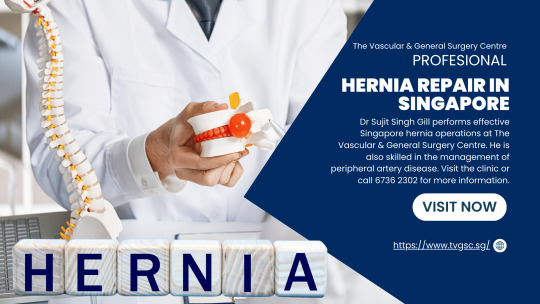
Overview of Hiatal Hernias
Understanding the intricate workings of hiatal hernias begins with an exploration of the diaphragm's role as a muscular barrier between the chest and abdomen. This section elucidates the anatomy and mechanism behind hiatal hernias, shedding light on the association with GERD and its consequences on digestive health.
Understanding its Origins
While the exact cause of hiatal hernias remains elusive in many cases, a comprehensive examination reveals contributing factors. Age-related changes in the diaphragm, injuries, congenital conditions, and lifestyle choices such as persistent coughing or heavy lifting can collectively weaken muscle tissue, creating an environment conducive to stomach protrusion.
Types of Hiatal Hernias
This section provides simple descriptions on the main types of hiatal hernias. The prevalent sliding hiatal hernia involves the stomach and lower oesophagus sliding into the chest, often causing GERD due to the malfunctioning of the esophagogastric valve. Conversely, the less frequent paraesophageal hernia presents a more serious risk, as part of the stomach pushes through the hiatus, residing next to the oesophagus without returning to the abdomen.
Common Hiatal Hernia Symptoms
An in-depth examination of symptoms associated with hiatal hernias reveals a spectrum of manifestations. Heartburn, regurgitation, difficulty swallowing, and abdominal or chest pain are prevalent, yet it's essential to underscore that some individuals may remain asymptomatic, particularly in the early stages.
Diagnosis Methods
There are several diagnostic methods for hiatal hernias. From the traditional barium swallow to the more advanced endoscopy and oesophageal manometry, healthcare professionals employ these techniques to assess the extent and nature of the hernia, facilitating informed decision-making regarding treatment.
Managing Hiatal Hernias
Treatment options for hiatal hernia include surgical interventions like Nissen Fundoplication, where the top of the stomach is wrapped around the lower oesophagus to reinforce the valve. Open surgery, reserved for larger or complex hernias, involves repositioning the stomach and reducing the diaphragmatic opening. Endoluminal Fundoplication (ELF), a less invasive option, creates a partial fold at the top of the stomach through the mouth. Additionally, medications such as antacids, H2 blockers, and proton pump inhibitors play a crucial role in managing symptoms.
When Surgery is Necessary
In scenarios where surgery becomes a consideration, the importance of evaluating factors such as hernia size and type come to the fore. Surgical intervention may be warranted for paraesophageal hernias due to the heightened risk of complications like strangulation or compromised blood supply. In cases where symptoms persist despite conservative measures or complications such as severe inflammation, bleeding, or ulcers arise, surgery emerges as a viable option.
Preparing for Hiatal Hernia Repair
This section describes the preparations done during preoperative phase. From fasting before the procedure to the administration of anaesthesia by an anaesthesiologist, the detailed exploration encompasses the entire journey, ensuring individuals are well-informed about what to expect on the day of the procedure.
Navigating the Recovery Journey
Postoperative care is a critical aspect of the overall treatment process. Detailing the immediate postoperative period, this section provides insights into hospital stays, pain management strategies, and dietary restrictions. It emphasizes the gradual transition from a liquid diet to solid foods as the body adapts to the changes induced by surgical repairs.
In summary, this guide serves as a comprehensive roadmap for understanding, managing, and recovering from hiatal hernias. It encourages individuals to approach their journey with proactive engagement, seeking personalized guidance from healthcare professionals to navigate the complex landscape of hiatal hernias effectively.
0 notes
Text
UNIT 3 | ASSESSMENT
1 Present evidence of a body of work that demonstrates a systematic enhancement of your knowledge and understanding. (AC Realisation)
“New Observations of the History of Bees” is the body of work I have produced across TERM 1, 2 & 3. The series consists of docu-fictional investigations on both organic and inorganic materials as primary sources to understand the impact of pesticides on the cognitive system of wild pollinators.
In these works there is a visible contrast between expressly abstract areas and highly detailed elements that represent some specific anatomical parts of insects (primarily the parts of their bodies affected by the chemicals). The abstract areas have the warmest on the magenta to blue colour scale, including some light degrees of yellow. These zones represent the insects' cognitive system, and are my personal interpretation and representation of the insects' awareness. As can be easily seen, the areas representing the consciousness of these insects cover larger areas than their anatomical elements.
The body of work includes mixed media painting on emulsified canvas and drypoint on paper. They are all wall based and in the last months I started designing three different installations, composed of diptychs of canvases that are mounted on the walls with only one vertical side each.
Link to New Observations on the History of Bees
Works from this series have been included in the following academic and professional exhibitions:
This Is Not a Party - CSM Interim Show 2022 at Trinity Buoy Wharf, London;
Woolwich Contemporary Print Fair 2022 at Woolwich Works in London; Press & Play 2022 at Phoenix Art Space in Brighton;
CSM MERCH 2022 at Koppel X, London;
E-ART-H / VISION-ARY at The Earth Vision Org in London
A solo show “Andrea Abbatangelo A.A.LLES” at the Atelierhaus Ludwig-Engel-Weg 1 for the festival Darmstädter Tage Der Fotografie in Darmstadt (Germany), where I was the artist in residency for this edition. Link here
Works from the series have also been included in two publications: 99 Future Blue-Chip Artists, published in 2022 by Artsted and #12 Darmstädter Tage Der Fotografie, published in 2023 by the Festival
In parallel with the production of the body of work, I have kept my attention for ten months on the same sample of a hoverfly fossil included in amber, experimenting several techniques of observation and representation. I have used both analog and digital cameras, table lens, hd scan and microscopes to observe direct details of the fossil. I have then developed those images with non chemical photographic processes, mainly cyanotype and a similar method based on vegetable chlorophyll fibres. The final work is a gouache on emulsified canvas.
Link here
The information collected from microscope observations, the readings of articles and the conversation with biologists helped me to create a series of drypoint on paper with anatomical details of bees.
Link to drypoint series
I have worked on one specific drypoint on paper consistently since Term 1 where three aspects of my research practice coexisted and influenced each other; pigment-making, drypoint and scientific readings. This work is titled ‘Ongoing Anatomy of Bee” because each time I learnt a specific challenge impacting the body and cognitive or social abilities of bees, I have gone back to work on this drypoint to represent it on the specific part of the body. In fact, gut bacteria, wings, pesticides-tongue.
Link to Ongoing Anatomy of Bee
2 Synthesise and critically reflect coherently on your process whilst providing evidence of an active, independent and/or collaborative practice. (AC Process)
My individual practice is evidenced by, for example, my ongoing activity, especially during Term 2 and 3, of searching and collecting fossil inclusions in amber, antique victorian microscope slides with bee tongues and pollen and magic lantern glass slides. This material was crucial to inform my practice with details of the anatomy of those insects before intensive agriculture used chemical pesticides.
Link to A2 Archiving Materials
I focused my collaborative practice on the role of art in the social engagement within natural and social sciences.
The core evidence of a research practice based on scientific resources developed in collaboration with prominent researchers is the series of investigations produced in Darmstadt (March - April 2023); specifically the work “Two Experiments with Pollution” and the microscope observations at the Technische Universität Darmstadt.
The conversation I had with Dr Lentz led me to explore two specific areas of bio-toxicology: gut bacteria (which I already explored during Summer 2022, see Post n 54 Part 3) and the very worrying rapid decline of pollinators in the forests around Darmstadt.
Prof. Boris Schmidt hosted me at his laboratory in the Clemens Schöpf-Institute of Chemistry and Biochemistry - Technische Universität Darmstadt and suggested that I research defects in wing development that indicate disturbed metamorphosis: phenotype "Notch" in the dew fly (Drosophila) is a genetically determined effect.
I undertook this whilst observing the development of mosquito larvae growing in puddles which were highly polluted with rust and residual car oil.
Link to Two experiments with pollution : Russet & Larvae
Link to Microscope Observations
As a result of exploring the information provided by both scientists in parallel, I was able to merge two divergent investigations and produce a personal and experimental research practice in which biology and art inspire and stimulate each other.
Over the three terms, I have improved my skills at the following and and all these developments have been self-managed:
printmaking (working at the Kew Printmaking Studios);
analog photographic printing (using the darkroom at H_DA - The Darmstadt University of Applied Sciences)
using a ‘state of the art’ scientific lab, experimenting with microscope settings and learning a method of sequential observing and storing the files.
I recently attended a workshop to refresh my knowledge in chemistry to produce soil chromatography with the aim to trace micro-references of chemical pathogens (i.e. forever chemical) and pesticides on the soil.
3 Summarise and evaluate your overall progress and formulate a constructive plan for continuing Personal and Professional Development. (AC Communication)
The most important progress I have made in the last two years has been learning how to reflect on my practice. For example, I have practised on several occasions an exercise based on conscious immersion of hand-writing that Jonathan demonstrated in two different sessions. I have embraced this self-reflective tool at each step of my research and it was incredibly powerful during my artist residency in Darmstadt.
More practically, I have also improved the quality and quantity of writing and audio recording (for example, the sound-walk at Block Beuys at the Hessisches Landesmuseum in Darmstadt) - I will investigate further this practice in the future.
Link to Block Beuys Sound-walk
I have found the feedback sessions particularly challenging but also beneficial. I have always found it hard to give feedback on the work of colleagues. This process has been very revealing because I have discovered methods of discussing and evaluating the work of colleagues in both individual and group settings which are effective but which I am also comfortable with.
I am currently archiving the material produced, collected, documented, exhibited and published during the last two years. To do so, I have bought an A1 Portfolio Carry Case and two A3 Portfolio boxes in cardboard. I am using, on a smaller scale, the cataloguing system of the Museum Collection CSM that we experimented with during the session of November 17th 2022.
I will complete the series of 82 drypoints on the hexagonal crystal of snowflakes [see Post n 58; 61; 63]. This research led me to the pioneering work of Wilson Alwyn Bentley who created a body of work on the subject between XIX and XX centuries . I started this research on hexagonal shapes in nature while investigating the Honeycomb Conjecture [see Post n 52 - Third Fictional Summer Session / July 22nd 2022], which also inspired me to create the work Saknussemm for the online exhibition curated by the Digifest 2022 - Durban University of Technology. I have printed only four hexagonal crystal snowflakes out of 82.
Link to the drypoint series
I plan to explore the series “New Observations on the History of Bees” implementing the method I adopted during the residency in Darmstadt, in which both the laboratory making and the interaction with researchers will allow the participation of groups of people or communities to be involved in the process. I intend to continue to work on the topics bridging art and natural sciences with a special focus on the impact of chemicals and pollution in the environment. My goal is to continue these investigations through socially oriented projects, ideally in public spaces to approach polarised topics obliquely in order to heal divisions and help find a way forward.
0 notes
Text
MRI SCAN
▪️John Korsah
1. Understanding the MRI scan
MRI stands for Magnetic Resonance Imaging. It is a medical imaging technique that uses a strong magnetic field and radio waves to create detailed images of internal organs, tissues, and structures inside the body. An MRI scan can help doctors diagnose a range of conditions, from soft tissue injuries to neurological disorders.
During an MRI scan, the patient lies on a table that slides into a cylindrical tube. The machine generates a powerful magnetic field that aligns the protons in the body's tissues. Then, radio waves are directed at the body, which cause the protons to spin out of alignment. As the protons realign with the magnetic field, they emit a signal that is detected by the MRI machine's sensors.
The data collected by the sensors is processed by a computer to create detailed images of the body's internal structures. The images are typically presented as cross-sectional slices, which can be viewed from different angles and magnified to examine specific areas of interest.
MRI scans are very safe and do not use ionizing radiation, unlike X-rays and CT scans. However, the powerful magnetic field can be dangerous for people with certain medical implants or devices, such as pacemakers or cochlear implants. It's important to inform your doctor and the MRI technologist if you have any implants or medical devices before undergoing an MRI scan.
2. Types
There are several different types of MRI scans, each with their own specific applications. Some of the most common types include:
▪️T1-weighted MRI: This type of MRI scan provides high contrast between different tissues in the body, making it useful for visualizing anatomy and detecting abnormalities in soft tissue.
▪️T2-weighted MRI: This type of MRI scan is particularly good for imaging fluid-filled structures, such as the brain, spinal cord, or joints. It can also detect inflammation, tumors, and other abnormalities in soft tissue.
▪️Functional MRI (fMRI): This type of MRI scan measures changes in blood flow to different areas of the brain, allowing researchers to map brain activity in response to various stimuli or tasks. It is commonly used in neuroscience research and can also help diagnose conditions such as stroke, epilepsy, and brain tumors.
▪️Diffusion-weighted MRI: This type of MRI scan measures the movement of water molecules in tissue, allowing doctors to detect changes in the microstructure of the brain or other organs. It is particularly useful for diagnosing strokes and detecting cancerous tumors.
▪️Magnetic resonance angiography (MRA): This type of MRI scan uses a contrast agent to visualize blood vessels and detect abnormalities in blood flow, such as aneurysms or blocked arteries.
▪️Magnetic resonance spectroscopy (MRS): This type of MRI scan measures the levels of different chemicals in the body, providing information about the metabolic activity of cells and tissues. It can be useful in diagnosing cancer, brain disorders, and metabolic disorders.
3. Purposes
MRI scans have a wide range of purposes in medicine and healthcare. Here are some of the most common:
▪️Diagnosing injuries and diseases: MRI scans can help doctors diagnose a range of injuries and diseases, from torn ligaments to brain tumors. They can provide detailed images of internal structures and soft tissues that are difficult to see with other imaging techniques.
▪️Monitoring disease progression: MRI scans can be used to monitor the progression of diseases such as multiple sclerosis or Parkinson's disease, allowing doctors to track changes in the brain or other organs over time.
▪️Planning surgery: MRI scans can help surgeons plan complex procedures by providing detailed images of the patient's anatomy. This can help reduce the risk of complications and improve surgical outcomes.
▪️Evaluating treatment effectiveness: MRI scans can be used to evaluate the effectiveness of treatments such as chemotherapy or radiation therapy, allowing doctors to monitor changes in tumors or other abnormal tissues.
▪️Research: MRI scans are widely used in medical research to study the structure and function of the brain, as well as other organs and tissues. They can help researchers understand the underlying mechanisms of disease and develop new treatments.
Overall, MRI scans are a valuable tool for diagnosing and treating a wide range of conditions and improving patient outcomes.
4. Risks
MRI scans are generally considered safe and non-invasive, but there are some potential risks and considerations to keep in mind:
▪️Contraindications: People with certain medical implants, such as pacemakers, cochlear implants, or some types of metal implants, may not be able to have an MRI scan due to the risk of complications. It's important to inform your doctor and the MRI technologist if you have any implants or medical devices before undergoing an MRI scan.
▪️Claustrophobia: Some people may feel anxious or claustrophobic during an MRI scan, especially if they have to remain inside the narrow tube for an extended period of time. Some facilities offer open MRI machines or provide sedation to help alleviate anxiety.
▪️Allergic reactions: Some people may have an allergic reaction to the contrast dye used in some types of MRI scans. Symptoms can include hives, itching, or difficulty breathing. If you have had an allergic reaction to contrast dye in the past, be sure to inform your doctor and the MRI technologist.
▪️Noise exposure: MRI machines can be quite loud during the scanning process, which can be uncomfortable or even damaging to the ears. Earplugs or headphones may be provided to protect your hearing.
▪️Cost: MRI scans can be expensive, and may not be covered by all insurance plans. Be sure to check with your insurance provider to understand your coverage and potential costs before undergoing an MRI scan.
Overall, the benefits of MRI scans typically outweigh the risks for most people. However, it's important to discuss any concerns or questions you may have with your doctor before undergoing an MRI scan.
5. Procedures
The procedures for an MRI scan typically involve the following steps:
▪️Preparation: Before the scan, you will be asked to remove any metal objects, such as jewelry or watches, and change into a hospital gown. You may also be asked to complete a questionnaire to ensure that it's safe for you to undergo the scan.
▪️Positioning: You will lie down on a table that slides into the MRI machine. The technologist will help you get into the correct position and may use straps or pillows to keep you still during the scan.
▪️Scan: The MRI machine will create a strong magnetic field and send radio waves through your body. You may hear loud knocking or buzzing sounds during the scan, which is normal. It's important to remain still and follow any instructions from the technologist.
▪️Contrast dye (optional): In some cases, the technologist may inject a contrast dye into your veins to help highlight certain tissues or structures in the images. This is generally safe, but some people may experience mild side effects such as nausea or a metallic taste in their mouth.
▪️Completion: Once the scan is complete, the table will slide out of the machine and you can get up and change back into your clothes. The images will be reviewed by a radiologist and your doctor will discuss the results with you at a later appointment.
The length of the MRI scan can vary depending on the type of scan and the area of the body being imaged. A typical scan may last between 30 and 60 minutes, but some scans can take up to 90 minutes or more. It's important to remain still during the scan to ensure that the images are clear and accurate.

0 notes